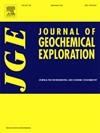Assessment of LUNAR, iForest, LOF, and LSCP methodologies in delineating geochemical anomalies for mineral exploration
IF 3.4
2区 地球科学
Q1 GEOCHEMISTRY & GEOPHYSICS
引用次数: 0
Abstract
Geochemical anomaly detection and delineation are crucial in mineral exploration, but they are challenged by high-dimensional data, complex inter-variable dependencies, and scarcity of ground truth labels for anomalies. Traditional outlier detection methods, including density-based and nearest-neighbor approaches, often misclassify anomalies close to the edges of the background data distribution, while ensemble methods face limitations in combining detectors effectively. Generic and global combination procedures frequently neglect local patterns in the data, leading to suboptimal detection of nuanced outlier characteristics, and the absence of robust selection processes can compromise ensemble performance due to underperforming detectors. To address these issues, this paper presents LUNAR (learnable unified neighborhood-based anomaly ranking), a novel outlier detection method that integrates graph neural networks with nearest neighbor analysis, and LSCP (locally selective combination in parallel outlier ensembles), which emphasizes local data structures and leverages pseudo-ground truth to optimize detector selection and improve score stability. This study also explored the efficacy of outlier detection methods, namely local outlier factor (LOF) and isolation forest (iForest) in detecting geochemical anomalies within the Varzaghan area, situated in the Ahar–Arasbaran zone of the Alborz–Azerbaijan Magmatic Belt. This region hosts diverse mineral occurrences, including porphyry Cu![]() Mo deposits (e.g., Sungun), epithermal base metal veins (e.g., Zaylik), and Fe
Mo deposits (e.g., Sungun), epithermal base metal veins (e.g., Zaylik), and Fe![]() Cu skarn deposits (e.g., Sungun and Anjerd). Compared to the LOF and iForest, for the analysis of a trace element geochemical dataset from 1067 stream sediment samples, the LUNAR exhibited the highest relative percentage of delineated deposits along with superior AUC (area under curve) from ROC (receiver operating characteristic) analysis for both mineral occurrences and mineralized samples. The LOF-detected outliers for elements like As, Sb, and Ti, whereas the iForest-detected outliers for Ti, Pb, and Co, and the LUNAR-detected outliers for Au and pathfinder elements like As, Bi, and Sb. Employing a graph neural network, the LUNAR efficiently captured intricate outlier relationships within the multivariate geochemical dataset, surpassing the LOF. Spatial analysis uncovered a correlation between LSCP variants and the LUNAR in detecting geochemical anomalies and their association with known deposits. Based on AUC values, the LSCP_A (average) demonstrated relative superiority over the LSCP_AOM (average of maximum), LSCP_MOA (maximum of average), and LUNAR. Among the LSCP variants, the LSCP_A showcased superior performance, leveraging average scores, and detecting outliers of pathfinder elements for gold like As and Bi, along with lithologically-influenced elements like Cr and Ti, and the significant role of Cu. The mapping of clr-transformed Bi data aligned closely with mineral deposits, accentuating signatures typical of porphyry deposits in the Varzaghan district, including Cu, Au, Mo, and Bi. Compared to the iForest, the LSCP, particularly the LSCP_A, showcased proficiency in detecting geochemical anomalies through a localized approach and in comprehensively capturing diverse anomaly patterns, thus rendering it a promising method for handling complex datasets.
Cu skarn deposits (e.g., Sungun and Anjerd). Compared to the LOF and iForest, for the analysis of a trace element geochemical dataset from 1067 stream sediment samples, the LUNAR exhibited the highest relative percentage of delineated deposits along with superior AUC (area under curve) from ROC (receiver operating characteristic) analysis for both mineral occurrences and mineralized samples. The LOF-detected outliers for elements like As, Sb, and Ti, whereas the iForest-detected outliers for Ti, Pb, and Co, and the LUNAR-detected outliers for Au and pathfinder elements like As, Bi, and Sb. Employing a graph neural network, the LUNAR efficiently captured intricate outlier relationships within the multivariate geochemical dataset, surpassing the LOF. Spatial analysis uncovered a correlation between LSCP variants and the LUNAR in detecting geochemical anomalies and their association with known deposits. Based on AUC values, the LSCP_A (average) demonstrated relative superiority over the LSCP_AOM (average of maximum), LSCP_MOA (maximum of average), and LUNAR. Among the LSCP variants, the LSCP_A showcased superior performance, leveraging average scores, and detecting outliers of pathfinder elements for gold like As and Bi, along with lithologically-influenced elements like Cr and Ti, and the significant role of Cu. The mapping of clr-transformed Bi data aligned closely with mineral deposits, accentuating signatures typical of porphyry deposits in the Varzaghan district, including Cu, Au, Mo, and Bi. Compared to the iForest, the LSCP, particularly the LSCP_A, showcased proficiency in detecting geochemical anomalies through a localized approach and in comprehensively capturing diverse anomaly patterns, thus rendering it a promising method for handling complex datasets.
LUNAR、ifforest、LOF和LSCP方法在矿产勘查地球化学异常圈定中的评价
地球化学异常检测和圈定在矿产勘查中至关重要,但它们面临着高维数据、复杂的变量间依赖关系和异常地面真值标签稀缺的挑战。传统的异常点检测方法,包括基于密度的方法和最近邻方法,经常对接近背景数据分布边缘的异常进行错误分类,而集成方法在有效组合检测器方面存在局限性。通用和全局组合过程经常忽略数据中的局部模式,导致对细微异常值特征的次优检测,并且由于检测器性能不佳,缺乏健壮的选择过程可能会损害集成性能。为了解决这些问题,本文提出了一种结合图神经网络和最近邻分析的新颖的异常点检测方法LUNAR(可学习的统一邻域异常排序)和LSCP(并行异常点集成的局部选择组合),该方法强调局部数据结构并利用伪地面真值来优化检测器选择并提高分数稳定性。本研究还探讨了局部异常因子(local outlier factor, LOF)和隔离森林(isolation forest, ifforest)等异常检测方法在Alborz-Azerbaijan岩浆带Ahar-Arasbaran带Varzaghan地区地球化学异常检测中的效果。该地区拥有多种矿床,包括斑岩型铜钼矿床(如Sungun)、浅成热液型贱金属脉(如Zaylik)和矽卡岩型FeCu矿床(如Sungun和Anjerd)。与LOF和ifforest相比,在对来自1067个水系沉积物样本的微量元素地球化学数据集进行分析时,LUNAR显示出最高的圈定矿床相对百分比,并且在矿物产状和矿化样本的ROC (receiver operating characteristic)分析中显示出更高的AUC(曲线下面积)。LOF探测到As、Sb和Ti等元素的异常值,而ifforest探测到Ti、Pb和Co等元素的异常值,luna探测到Au和As、Bi和Sb等探路者元素的异常值。利用图神经网络,LUNAR有效地捕获了多元地球化学数据集中复杂的异常值关系,超过了LOF。空间分析揭示了LSCP变异与LUNAR在探测地球化学异常及其与已知矿床的关联方面的相关性。基于AUC值,LSCP_A(平均值)比LSCP_AOM(最大值的平均值)、LSCP_MOA(平均值的最大值)和LUNAR表现出相对优势。在LSCP变体中,LSCP_A表现出优异的性能,可以利用平均分数,检测As和Bi等金的探路者元素,以及Cr和Ti等岩性影响元素,以及Cu的重要作用。clr转换后的Bi数据与矿床密切相关,突出了Varzaghan地区斑岩矿床的典型特征,包括Cu、Au、Mo和Bi。与ifforest相比,LSCP,特别是LSCP_A,在通过局部方法检测地球化学异常和全面捕获各种异常模式方面表现出了熟练程度,从而使其成为处理复杂数据集的一种有前景的方法。
本文章由计算机程序翻译,如有差异,请以英文原文为准。
求助全文
约1分钟内获得全文
求助全文
来源期刊

Journal of Geochemical Exploration
地学-地球化学与地球物理
CiteScore
7.40
自引率
7.70%
发文量
148
审稿时长
8.1 months
期刊介绍:
Journal of Geochemical Exploration is mostly dedicated to publication of original studies in exploration and environmental geochemistry and related topics.
Contributions considered of prevalent interest for the journal include researches based on the application of innovative methods to:
define the genesis and the evolution of mineral deposits including transfer of elements in large-scale mineralized areas.
analyze complex systems at the boundaries between bio-geochemistry, metal transport and mineral accumulation.
evaluate effects of historical mining activities on the surface environment.
trace pollutant sources and define their fate and transport models in the near-surface and surface environments involving solid, fluid and aerial matrices.
assess and quantify natural and technogenic radioactivity in the environment.
determine geochemical anomalies and set baseline reference values using compositional data analysis, multivariate statistics and geo-spatial analysis.
assess the impacts of anthropogenic contamination on ecosystems and human health at local and regional scale to prioritize and classify risks through deterministic and stochastic approaches.
Papers dedicated to the presentation of newly developed methods in analytical geochemistry to be applied in the field or in laboratory are also within the topics of interest for the journal.
 求助内容:
求助内容: 应助结果提醒方式:
应助结果提醒方式:


